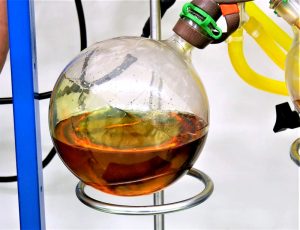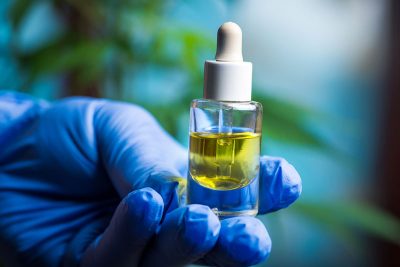 It’s more the quality of cannabis plants, plus the quality of manufacturing, than the method of extraction itself. But, if we’re ranking extraction processes, the best CBD oil for dogs will come from carbon dioxide extraction. This method is safe, as CO2 is a common food additive, and it’s highly unlikely to taint or damage CBD in any way that would make it unfit for humans or canines.
It’s more the quality of cannabis plants, plus the quality of manufacturing, than the method of extraction itself. But, if we’re ranking extraction processes, the best CBD oil for dogs will come from carbon dioxide extraction. This method is safe, as CO2 is a common food additive, and it’s highly unlikely to taint or damage CBD in any way that would make it unfit for humans or canines.
Extraction via solvents is generally considered the least favorable CBD production method because it comes with the risk of over-extracting, bringing by-products such as chlorophyll and other potentially harmful contaminants along with the good stuff.
What do we mean by CBD oil quality?
It’s not a simple question: while high-quality oil should be free of unwanted additives or impurities, there are a bunch of other variables that could go into judgments on oil quality. For instance, how concentrated is the isolated CBD after extraction, how consistent are batches of extracted oil, and what kind of plant is the oil extracted from in the first place?
So, CBD oil quality can mean different things depending on what you and your dog are looking for. Are you after the purest oil, the strongest, the safest—or even the easiest to make at home?
In terms of quality and extractions, most of what we want to consider is whether the extraction method allows manufacturers to carefully control the cannabinoids and terpenes going into their products, so that you as an owner can feel confident in knowing exactly what type of CBD you’re giving your pet.
CBD extraction method #1 – Solvents
 Solvent extraction gets the CBD from cannabis by soaking it in low-grade alcohols or hydrocarbons—most often ethanol and butane. The solvent is mixed with plant ingredients and left to strip off the CBD and other cannabinoids, plus flavors and terpenes. Once extracted, the mixture is heated to evaporate the solvent, which is possible thanks to the low boiling points of of hydrocarbons, leaving the CBD constituents behind.
Solvent extraction gets the CBD from cannabis by soaking it in low-grade alcohols or hydrocarbons—most often ethanol and butane. The solvent is mixed with plant ingredients and left to strip off the CBD and other cannabinoids, plus flavors and terpenes. Once extracted, the mixture is heated to evaporate the solvent, which is possible thanks to the low boiling points of of hydrocarbons, leaving the CBD constituents behind.
Ethanol extraction has a long history and has been proven able to safely extract a full spectrum of cannabinoids from plants. However, some believe that solvents are liable to extract too much from hemp plants, resulting in products with lower purities and potencies. Any contaminants that do find their way into extractions (the most common by-product being chlorophyll) can be removed by filtering the extract, but this usually reduces the strength of the final CBD product.
Butane, on the other hand, tends to offers stronger final CBD oils, but some say extractions are more likely to contain leftover solvent traces, which may be irritants, especially if inhaled during human consumption.
How does this method affect CBD oil quality?
Checking manufacturing quality is paramount when giving your dog CBD that’s been extracted by solvents. .
Concerns about toxicity have led to a general decline in solvent extraction as CBD becomes more commercial and mainstream. California state code now requires a higher grade of license for butane extraction than it does for methods using ethanol or CO2.
In terms of cannabinoid concentration, solvent extraction may also destroy certain beneficial waxes on the cannabis plant. All of which goes to say that solvents are generally viewed as an inferior extraction method by manufacturers and consumers alike.
CBD extraction method #2 – Oil infusion
 Without a doubt the most popular home-extraction method, oil infusion involves extracting CBD via the same carrier oil through which the cannabinoids will later be consumed by your pup.
Without a doubt the most popular home-extraction method, oil infusion involves extracting CBD via the same carrier oil through which the cannabinoids will later be consumed by your pup.
The extraction process begins by heating cannabis well below its burning point in order to begin the chemical release cannabinoids and terpenes. Once completed, the now pungent plant material is combined with your choice of carrier oil—commonly olive, coconut, or hemp seed—and further heated for a period of several hours.
After cooling and filtration to remove solid plant particles, the CBD oil should be ready for your dog!
How does this method affect CBD oil quality?
Oil infusion is likely the only extraction method fit for use at home, which makes quality a moot point for committed home brewers (is ‘brewer’ the correct term?). However, the reality is that extraction via carrier oil is an inferior method when it comes to important qualities like CBD strength, taste, and purity.
Using infused CBD oil means your dog will need to consume the oil you infused your CBD in, and good options for extraction—like olive oil—often aren’t necessarily the best oils for your dog to eat on a regular basis. Dogs with proud personal-hygiene routines may also attempt to lick off topically applied CBD-olive oil.
In terms of production, oil infusion tends to produce fairly low yields, and oil will be perishable unless preservatives are added. Perhaps more importantly, oil infusions are not concentrated, meaning that potency is likely to be very low.
CBD extraction method #3 – Carbon Dioxide
 CO2 cannabis extraction uses equipment able to pressurize carbon dioxide into non-gaseous states. When pressurized, the CO2 is able to pull CBD and other cannabis constituents from plants in a highly efficient, safe manner.
CO2 cannabis extraction uses equipment able to pressurize carbon dioxide into non-gaseous states. When pressurized, the CO2 is able to pull CBD and other cannabis constituents from plants in a highly efficient, safe manner.
Speaking in layman’s terms, compressing, cooling, and sometimes freezing CO2 allows it to act like the hydrocarbon solvents used in method #1. Once the CO2 has pulled the cannabinoids and essential oils from the hemp plant, the thick, sludgy mixture is usually passed through a separator, which breaks it down into requisite parts.
This process allows manufacturers to be super-accurate in creating their CBD oils, combining different elements of cannabis, or leaving the CBD as a pure isolate. All the good stuff is then collected while the CO2 goes through a condenser and is turned back into a liquid for reuse.
Depending on the pressure and heat used, CO2 extraction can fall into several categories. The main two are supercritical and subcritical extraction:
- Supercritical extraction is in many ways the current standard for commercial CBD oil production. Thanks to its ability to produce safe CBD in a relatively quick time, it may be the most regularly used extraction method in the US. At supercritical levels, CO2 hovers halfway between a liquid and gas, simultaneously holding properties from each state. Manufacturers are able to use CO2 in this state to produce highly potent CBD.
- Subcritical extraction uses CO2 at lower temperatures and pressures. While this method usually takes longer and produces a smaller yield, it tends to extract less unwanted byproducts and larger molecules such as chlorophyll—as well as being less likely to damage delicate terpenes. While supercritical has been considered the optimum extraction within the industry for some time, subcritical is increasing in popularity.
How does this method affect CBD oil quality?
Giving your dog CBD oil extracted via carbon dioxide is a great way to provide extra insurance against unwanted extraction byproducts, or contaminants in oil as a result of production. Even if excess CO2 were to somehow find its way into your dog’s oil, the effect would be no different to them consuming a small amount of soda, or other carbonated products.
Using CO2-extracted oil also safeguard quality in the sense that the method is cost-prohibitive, meaning that it tends to only be used by serious market players. For those manufacturers, the ability to alter CO2 pressure and temperature allows them to be selective in the compounds they extract from cannabis.
Here’s some other relevant terminology
Distillation
CBD distillation is no different in theory to other forms of distilling used in food and drink production. By heating and condensing the oil potency can be dramatically increased (up to >80 percent), leading to the higher strength tinctures, capsules, and other products appearing in pet stores and human dispensaries.
Winterization
Winterization sounds a lot cooler than it actually. The process involves an alcohol wash, which can be applied to extracted oil or the original cannabis plant itself. Similar to solvent extraction, winterization will help further extract cannabinoids and terpenes, making it an alternative to distillation for producing highly pure, concentrated CBD.
The process is called winterizing because the alcohol-soaked CBD extract is usually then frozen. Freezing (under lab conditions) allows manufacturers to isolate and separate different compounds in the oil, by controlling the temperature for their melting and precipitation points.



